Slow Cooking in the Woodfired Oven with just the Retained Heat
If you’ve fired up your refractory oven and done some high heat cooking in it, then it makes so much sense to use that retained heat you’ve pumped into it to do some slow cooking. Traditionally this is how a village bakery oven would be used certainly in France – the baker finishes his day’s breadmaking and heads off to bed for a nap while his wife sells the bread and takes in the villagers’ pots of meat and/or vegetables to slow braise in the falling heat of the oven while they go off to work; hence potatoes boulangere and other good stuff.
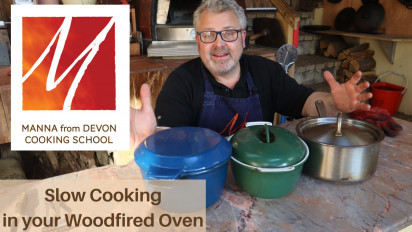
Slow Cooking in the Woodfired Oven with just the Retained Heat
In this Woodfired Workshop David is showing you how to cook 3 different dishes in the retained heat of our Bushman Santorini whilst shutting the door and going off to do other stuff – finish the crossword, take the dogs for a walk, have a nap…. This is a great way of cooking for a crowd or for your week of meals ahead, as long as you get organised in advance!
Know your Oven
Obviously every oven is different – we use ours a lot for this kind of cooking and know how long it will retain its heat. Also it’s under cover so not left out to get damp in all weathers and is in use regularly. Only you will know your oven and experience will tell you how much heat it retains, how much oomph the battery has for how many slow-cooked dishes (Not a real battery obviously; it’s just a metaphor but one we find useful) so these notes and the video are a guide to using yours. Use it for cooking lots of things and get to know how it works and adapt what we’re saying.
Chicken Stock
We will always put a pan of stock in the oven after we have had a woodfired roast chicken – it’s not difficult and it saves all that simmering on the hob and infusing the house with the smell of stock cooking. We then use the stock for soups, gravies, braises, risottos, bean dishes, pommes boulangere – you get the picture!
To make the stock, put the chicken carcass (bones, skin, any leftovers) into an ovenproof pan. Add a couple of chopped onions (skin on is fine) with a large, roughly chopped carrot, a stick of celery, a few black peppercorns and some herbs – a bay leaf or 2, some parsley stalks, some sprigs of thyme. Cover with water and put the lid on tight and put it in the oven when it’s around 180C. Shut the door, come back the next morning to a pan of fabulous chicken stock.
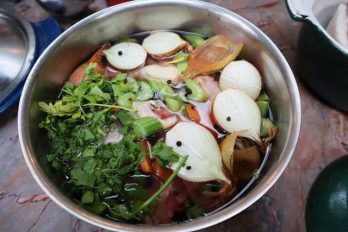
The stock pot ready for the oven
Strain the stock into a bowl (we then pick through the chicken bits and veggies for the carrots and meat for our dogs and discard the rest). Let the stock cool, put it in the fridge and use it as you need it. We have put this strained stock into a wide deep pan and then into the oven the next day after more cooking at around 150C, shutting the door again to reduce right down so it doesn’t take up so much space in the fridge. Pour it into a smaller bowl or jug and let it cool. It may well become a jelly which I love and is a super fully-flavoured stock for using as normal. You can also freeze the stock in small plastic boxes or ice cube trays and use the stock from the freezer if you don’t think you will use it very quickly. We use a lot so just keep it in the fridge.
Our BBQ-style Beans
There are so many ways of cooking beans so don’t stick to just this one. Our friend and cook Jenny Chandler has a great range of bean dishes in her book all about them, aptly named Pulse. We soak the dried beans overnight and then boil them for 10 minutes before draining them and adding them to the rest of the ingredients but they could easily have been curried, garlicky, chilli-flavoured….We don’t add salt as it can interfere with the beans softening during cooking so don’t forget to season them once they are cooked.
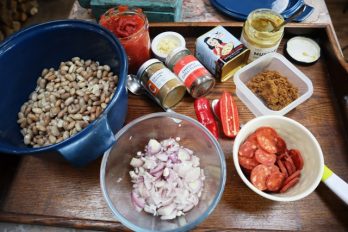
All the bean dish ingredients
For 500g soaked dried beans (then drained, boiled for 10 minutes in fresh water and drained again), we mixed up 1 x 400g tin chopped tomatoes; 1tbsp tomato purée; 2 peeled and chopped onions; 80g chopped cooking chorizo; 1tsp ground cumin; 1tbsp smoked paprika; 1 tsp dried ancho chilli flakes; 4 large garlic cloves, peeled and crushed; 30g light Muscavado sugar; 1tbsp French mustard. All this gets mixed together with a deseeded fresh red chilli in an ovenproof pan and then covered with chicken stock. Put on a tight fitting lid. Check half way through cooking in the shut oven in case the beans are drying out; top them up with water or stock if they are.
Pulled Ham
We soaked a 1kg gammon from our butcher in cold water overnight and then rinsed it; took off the sting and the skin and put it in an ovenproof pan. Add to that 30ml cider vinegar, 1tsp ground black pepper, 1tsp dried chilli flakes and 2tbsp marmalade. No salt needed as the gammon will be salty enough as it is. Lid on tight.
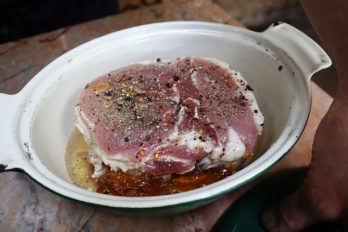
Marmalade may sound odd but it works – trust us!
Into the oven
These 3 cold dishes went into the oven (there was a bed of inactive embers in there) with their lids on tight and the door shut. If your lids are not so tight, put a layer of foil between the pan and the lid. The temperature was about 180C/350F.
Now it helps if you think of the oven as a battery – the heat/energy from the oven/battery will move into the cold pans and heat up the ingredients inside and start cooking them. During the first 2-3 hours there will be quite a big drop in oven temperature and then that will stabilise dropping only another 10 degrees or so for the last 3 hours cooking – or that’s how our oven works as it’s well insulated and was pumped full of heat. It’s just physucs – but certainly more interesting than when I was at school!
Tempting as it is to take the door off the oven and have a look at what’s going on, try not to as you will lose heat more quickly that way. David only checked these dishes once in a 6 hour cook.
For us the safe zone for slow cooking is 100-200C – the dishes will simmer and cook slowly in the falling heat of the oven but the heat is not so hot as to dry everything out or burn it. But remember every oven is different so time and experience will tell you how your oven works.
That’s it!
So that’s it – trial and error and getting to know how your oven works and just how long it will hold its heat. These dishes work well in the falling heat of the woodfired oven as you’ve seen but don’t stop there – there’s also slow-cooked shoulder of lamb; lamb curry; ox cheeks or oxtail; potatoes boulangere (of course) or potato dauphinoise – silky and tender with garlic, cream and nutmeg; osso buco; and so much more!
Do let us know how you get on – we love to hear from you. And we explore more slow cooking on our Woodfired Expertise course here at the cooking school so do make sure to join us on that.
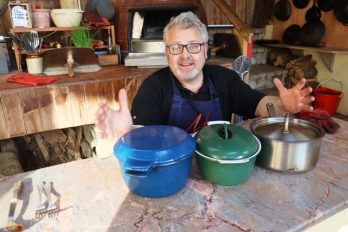
Back soon with more woodfired cooking!

